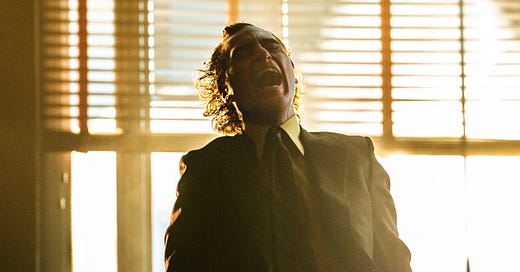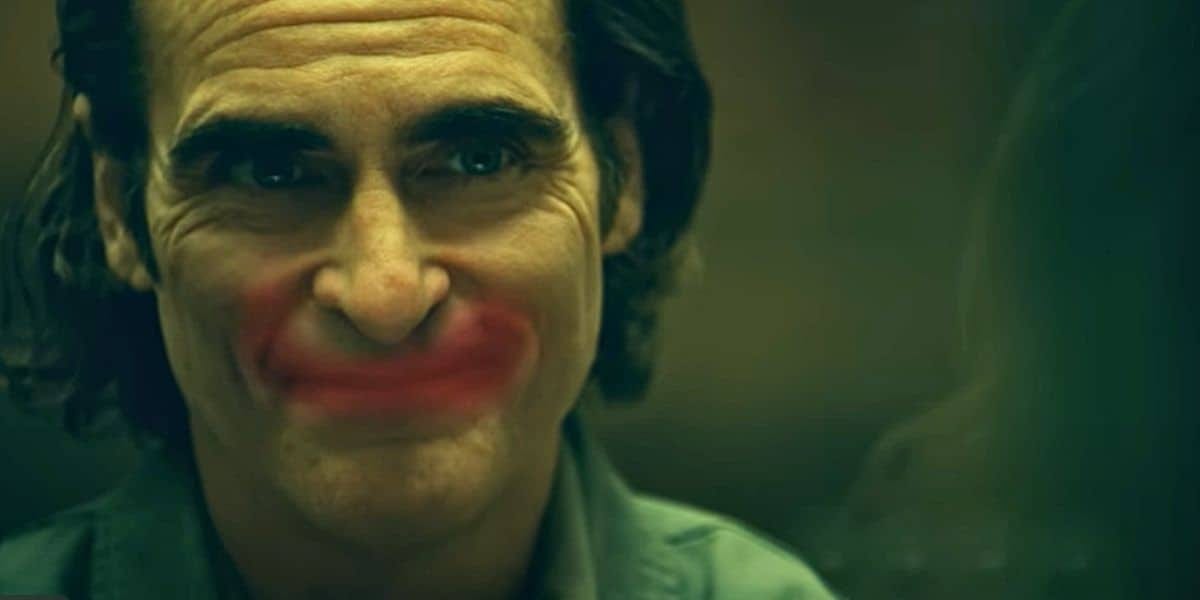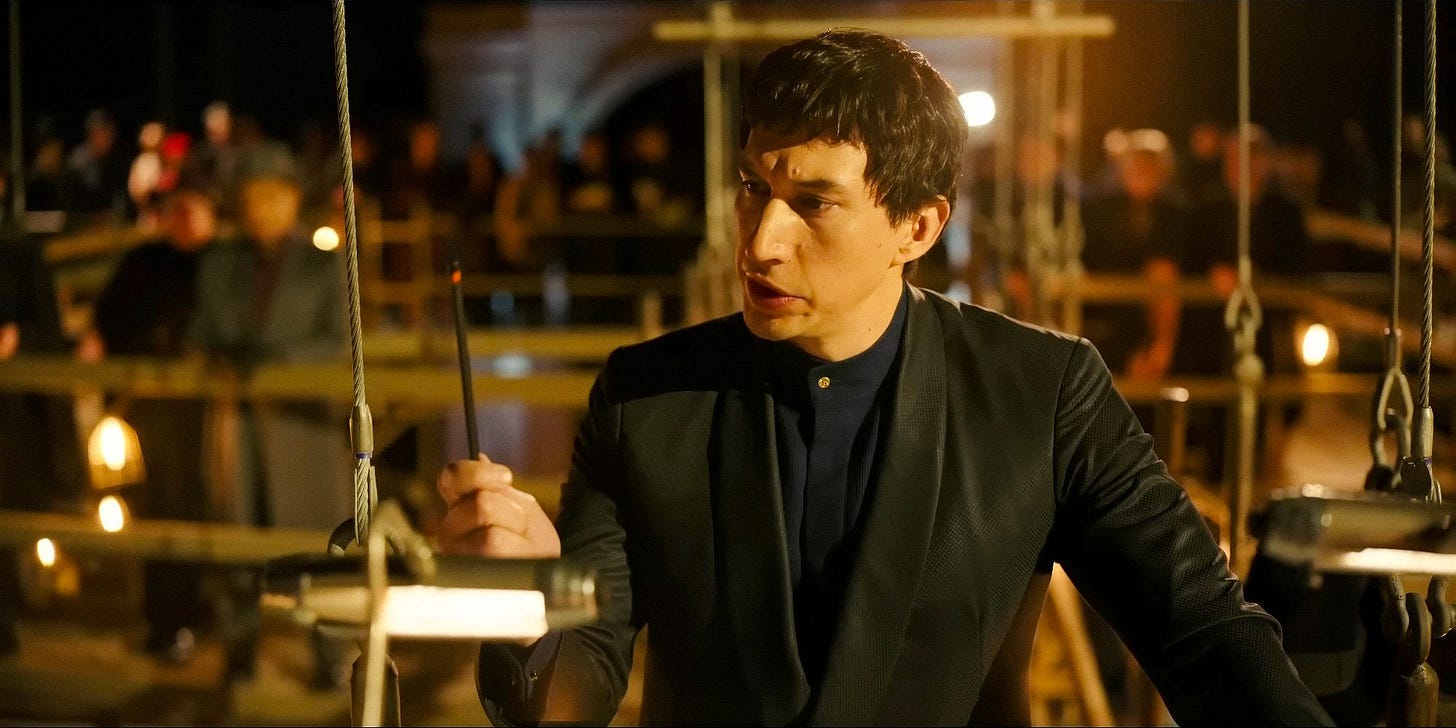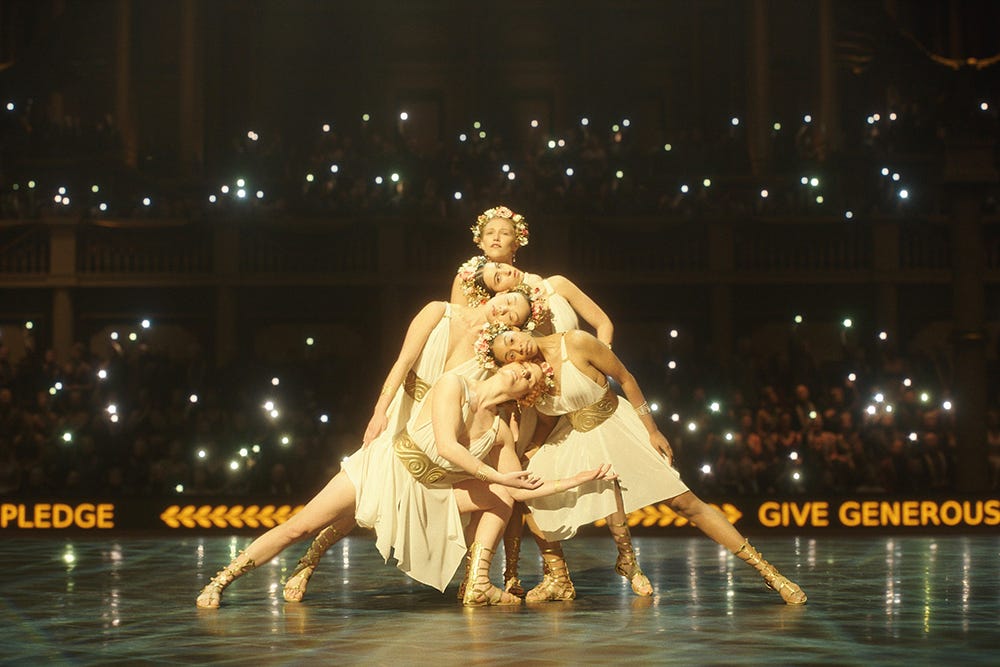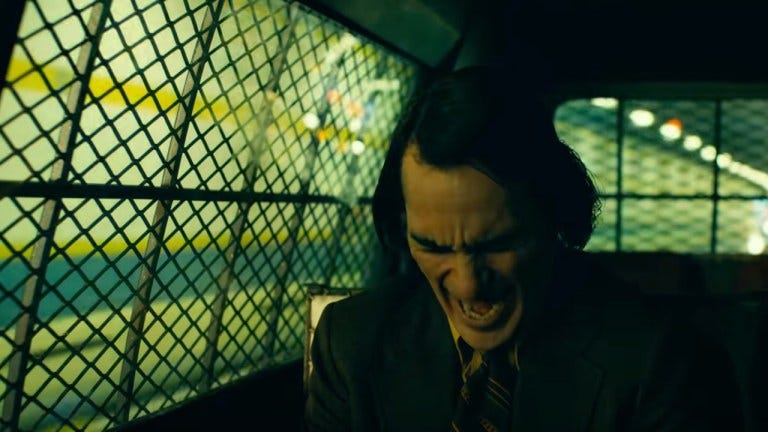Apologies if the expiration date for “Barb-Enheimer” jokes has officially passed, but after having recently seen Todd Philip’s Joker: Folie à Deux and Francis Ford Coppola’s Megalopolis in back-to-back fashion, I was left chuckling about what an inverted, distorted echo they conjured of that bygone summer when everyone was simultaneously wearing pink and pondering the ashes of Hiroshima and Nagasaki. By comparison, the “Joke-à-Lopolis” craze is not exactly taking off. Personally, I find this bizarre duo far more interesting and entertaining than either Barbie (which I enjoyed) or Oppenheimer (which I did not), even though both have received highly mixed critical responses and decidedly poor audience support. While it’s become de rigueur to champion any uptick in box office numbers, regardless of the quality of the films or the conversation around them, I can’t help but root for the beautiful losers that push back at that flawed notion. Joker: Folie à Deux seemingly does this with great intention, while Megalopolis does it with blind abandon. Both films manage, somehow, to be wildly compelling cinematic events without being particularly “great” movies. Both films are seemingly attempting to re-assert something they feel is missing from the current cinema, and take such huge creative swings that it’s impossible to dismiss them as mere flops.
Joker: Folie à Deux is the follow-up to Todd Philip’s 2019 film Joker, which also starred Joaquin Phoenix as the titular, conflicted and afflicted comic book villain. The first Joker didn’t leave much of an impression on me. It was apparent that Philips was paying homage to one of the great Scorsese films, The King of Comedy (1982), but it never quite managed to emerge from that film’s substantial shadow. More significantly (and not unlike Scorsese), my enthusiasm for new iterations of comic book properties had been completely smothered by that point. I say this as a “comic book kid” who grew up loving and collecting the very comics that were adapted into the films that often revitalized the box office over the last twenty years. While I don’t consider myself a “comic book adult,” I’ve consistently been fascinated by the evolution of how those characters and stories have evolved cinematically over time, but the more directors like Christopher Nolan (The Dark Knight, 2008) and Matt Reeves (The Batman, 2022) incrementally steered those stories toward so-called “gritty” realism, the more I tend to prefer the camp and color of Adam West-era Batman.
To cut to the chase, I think Joker: Folie à Deux is an outright snide joke on anyone who wants to see a movie where the Joker does a bunch of cool Joker stuff. And that’s part of why I kind of loved it. It’s a “Joker” movie for people who have developed a sort of disdain for “Joker” fandom, as well as the bloat and repetition of comic book movies on the whole. Philip’s accomplishes this in multiple ways, but primary among them is by rendering his sequel as a musical. The joke here is not only on the comic book movie audience, but also on the increasing vapidity of musical culture. Again, another reason I kind of loved it. I don’t know a lot about Philips, other than he directed The Hangover movies. I haven’t seen any of his comedies, but I’ll applaud him for making one of the funniest cinematic jokes of the year: a two hour and eighteen minute musical featuring the vocal stylings of Joaquin Phoenix. And, yes, the audacity of this is tempered by the wonderful voice and presence of Lady Gaga (a genuine actor from her first scenes in A Star is Born on) who takes on the inadvisable task of playing Lee “Harley Quinn” Quinzel after Margot Robbie’s unforgettable turn in the role. It’s to Robbie’s credit that she’s so memorable in a mostly forgettable string of films, and part of the reason Gaga’s performance works is because it has so little to do with any of them.
The remarkable thing that happens about three quarters of the way into Joker: Folie à Deux, perhaps around the time the film slows to a hypnagogic lull with Joaquin singing a serenade into a prison telephone—perhaps because it’s become utterly clear that Joker is not going to do any cool Joker stuff—is that it forces one to ponder what this strange film is actually about. It should be said that the film’s construction as a musical is not unlike Lars von Trier’s Dancer in the Dark, which similarly doesn’t fully emerge as a musical until late in the film, and whose musical sequences are always subjective, psychological manifestations of the main character. Joker: Folie à Deux never relies on the traditional suspension of disbelief that most musicals employ, with scenes of dialogue yielding and transforming into musical numbers. Instead, the musical components are clearly generated from the psychosis of Arthur Fleck/Joker. And Fleck/Joker’s psychosis is largely what the film is about.
Philips hasn’t made a film about the Joker of the comics, or even the beloved animated iterations of the perpetually smirking supervillain. In fact, he deflates the expectations of those depictions pointedly through an opening Warner Bros. cartoon that is both satirizing the character through style and establishing the “dual madness” of the title, which is ultimately far more about Fleck v. Joker than Joker + Lee. Philips is also not interested in the edgy, anarchic villainy that generated so much fanboy love in the Nolan films via Heath Ledger’s performance. What Philips and Phoenix ask of us with Joker: Folie à Deux is to consider Fleck/Joker purely as a working class psychotic unable to find any help within social systems, within the court, within society at all. This angle on the character was clear from the first film, but the mostly prison and courtroom-set sequel takes the character to an even bleaker and challenging end for audiences, far past the poser grittiness of previous renditions, and then glibly sprinkles in a few musical delusions to temper the glaring and urgent reality of it all. It’s a surprisingly blunt attack at both the problematic, romantic notion of the Joker and the Musical alike.
Yet, as a Musical, Joker: Folie à Deux is fairly enjoyable, manifesting the song and dance numbers from Fleck’s mental jukebox—a hodgepodge of 70’s variety show pop and musical numbers from classic films he once watched with his mother (Frances Conroy, who Fleck murdered in the first film). Some of the musical refrains resonate in clever ways with the subversive goals of the film—particularly “That’s Entertainment” from The Bandwagon (1953), which seems to bond Arthur and Lee. The prominence of this refrain only bolsters the delightfully contrary attitude of the film. The bigger joke of it all, and the commitment of Phoenix, compensates for the occasional soupiness of it’s construction—ultimately as much a prison film and courtroom drama as it is a musical.
Another refrain that lingers is the recurrence of “When the Saints Go Marchin’ In,” which is one of the first pieces of incidental music we hear in the film. But to read Fleck/Joker as a “saint” because of the deliberate kisses he lays on the well intentioned—his innocent inmate (Jacob Lofland) and his defense attorney (Katherine Keener)—may be oversimplifying things a bit. There’s not only a blatant disregard in the film for anything that made the Joker a popular character in the past, but a fascinating denial to reduce his character in any particular way. Fleck/Joker is neither saint nor villain. He doesn’t find his salvation in either love or chaos. And the ultimate resolution of the internal struggle depicted in the opening cartoon (“Me and My Shadow”) pulls the rug out from under all expectations entirely. It’s difficult not to stand up and applaud such a risky take on a character steeped in expectations…which is exactly what I did, since I saw it alone in an IMAX cinema.
Francis Ford Coppola’s true passion project Megalopolis shares a few qualities and preoccupations with Joker: Folie à Deux. Both films (which, oddly, have the exact same runtime) have little interest in pleasing the masses, but a great interest in depicting the disenfranchised masses outside the gates of power. The “Megalopolis” of the title is the utopian city of the future dreamt by lanky protagonist Cesar Catalina (Adam Driver), and the city that lies within the gates of the film is New Rome, ruled by Mayor Cicero (Giancarlo Esposito). Caught between them is Cicero’s daughter Julia (Game of Thrones and Fast and Furious actor Nathalie Emmanuel), who seeks to rend Cesar’s affections from his obsession with his deceased wife, Sunny Hope (Haley Sims). It’s all very Shakespearean in it’s plot and character design, with the all-star participants including Jon Voight as wealthy overseer Crassius, Shia LeBeouf as jealous and incestuous Clodio, Aubrey Plaza as media icon and schemer Wow Platinum, and Laurence Fishburne in the most awkwardly positioned role of the lot, Cesar’s servant Fundi Romaine, who also does omniscient voice-over narration duties. Often Fishburne’s voiceover merely reiterates what’s being shown to us on screen—thuddingly obvious epigraphs inscribed in the stone walls of the city, like: “When does an empire die? Does it collapse in one terrible moment? No, no... But there comes a time when its people no longer believe in it.” The film is a futurist fall of Rome whose parallels with contemporary America are as obvious as it sounds, yet somehow maddeningly complicated and oddly compelling.
Did I mention Cesar can stop Time at will, as well? This ability is a surprisingly underused aspect of the film as the story unfolds, but it is in there. In fact, the film begins with Cesar taking a leap of faith off a tall building, then asking time to stop before he plummets to his death. I’m not sure why he couldn’t just ask time to stop without taking a fatal step…but, in any case, it jarred my memory toward a 1980 TV movie starring Airplane! lead Robert Hays called The Girl, the Gold Watch, and Everything. My 8-year old self thought a man who could stop time and move around the frozen world through the aid of a magic watch was nothing short of the greatest visual idea ever committed to film. How Francis Ford Coppola fails to make even the slightest magic out of this borrowed sci-fi concept, or evoke little that’s dramatically potent or politically resonant throughout while trying so goddamned hard is beyond me. The film moves quickly from the “frozen time” opening sequence into a melange of artifice and histrionics that is, honestly, a difficult sit around 20 or 30 minutes in. The theatricality, the excess, and the satirical comedic reach of it all register as aspects that might normally intoxicate me, but the disappointing impact of the film, at that point, was akin to being sold a bag of oregano. For instance, early on Cesar lamely recites the “To Be or Not To Be” monologue from Hamlet, and when he ponders whether “he himself might his quietus make with a bare bodkin?” he pauses for a moment and ad libs: “Where’s my bodkin?” Megalopolis, at this point, was such rough going that I instinctually replied in my head: “Where’s my bodkin, indeed!?” To stay at the AMC, or not to stay? That was the question.
So, I stayed. And it began to grow on me. It’s not an easily digested movie, and maybe not a “great” one by any traditional measure. It’s not subtle, and it’s not funny. It’s not provocative, nor is it particularly poignant. It’s neither well acted (for the most part—I’ll give a pass to Plaza and LeBoeuf), or well directed. It has the design aesthetic of a Donald Trump bathroom, and sometimes echoes the production value of Tommy Wiseau’s The Room. In fact, (as long as I’ve already used a terrible movie like The Girl, the Gold Watch, and Everything as a reference point) I thought about Wiseau a surprising amount while watching Megalopolis, and I don’t mean that entirely as an insult. It’s difficult to deny that many of the performances reach Wiseau-esque heights—in all truth, he might be a specific reference point for moments of Driver’s performance!—which leads one to ponder the relationship between Wiseau and Coppola. If nothing else, they’ve made two of the most gigantically entertaining expressions in movie history of their utter creative disconnect from the world and their own work. Already, many defenders of Megalopolis have trotted out this old horse: “It won’t be appreciated for years to come! It’s ahead of it’s time!” And it may be true that Megalopolis will endure, but not due to hidden depths within that can’t be understood by the unevolved critical minds of the present. No, it will likely be something more akin to midnight screenings of The Room, minus the spoons and footballs whatnot.
Before I begin to sound too dismissive, let me be clear: Megalopolis is too grandiose and mesmerizing to be dismissed. Whether or not you consider it a failure is beside the point, and how anyone could be bored with it is beyond me. And to label it as pretentious is just too easy. Pretentiousness is just one of many brushstrokes that makes this massive independent production such a vibrant and perplexing work of art. In fact, it might be an homage to pretentiousness. Or, it might be that Coppola’s instincts in resurrecting this script—first penned in 1980, followed by a halted production in the early 2000’s—are completely and delightfully estranged from anything like marketable cinema. This unmarketability is certainly evidenced by much of his post-millenium output, including the very little seen Youth Without Youth (2007), Tetro (2009), and Twixt (2011); films that hold interest for certain cinephiles, but get little play otherwise. And, when you think about it, why wouldn’t Francis Ford Coppola be living on some distant creative planet? The product of that rare lived perspective is fully on display here, and while it’s somewhat puzzling, often frustrating, and occasionally downright psychedelic, it’s also more interesting and entertaining than a huge swath of mainstream cinema.
Other random, fascinating things that happen in Megalopolis:
Driver and various acting partners appear to integrate acting exercises into the fabric of the film, giving the odd effect of watching flashes of rehearsal footage within the finished film
Jon Voight hides a crossbow under his blanket, calls it his “boner,” then shoots Shia LeBeouf in the asshole with it
Giancarlo Esposito is head-butted by a baby in the final scene, and they just keep rolling
Multiple other actors appear throughout the film in fairly decorative, thankless roles. Some have a quality moment or two, like Jason Schwartzman and Talia Shire, while others are just there: Dustin Hoffman, Kathryn Hunter, and current SNL cast member Chloe Fineman. A few I didn’t clock at all, like James Remar, D.B. Sweeny, and Balthazar Getty
Grace VanderWaal is involved in some of the best sequences in the film where she plays a Miley Cyrus/Taylor Swift-esque popstar named Vesta Sweetwater, cloned and wearing a high-tech dress of invisibility as she swings on quarter moons above the audience
So, there’s more to say about Megalopolis than one pass can cover. Part of the appeal has to do with how much it reflects a time when there was an audience for huge, absurd, audacious, and—yes!—pretentious satire! And how harshly it reflects a current industry that leaves little room for confrontation, contemplation, stangeness, and discovery. This, I think, is what Coppola has a firm grasp on. Megalopolis sits nicely on a shelf alongside Richard Kelly’s underrated Southland Tales (2006) or Spike Lee’s (somewhat less successful) take on Lysistrata, Chiraq (2015). Leos Carax’s wonderful musical Anette is also on that shelf, featuring a much more successful use of artifice and Adam Driver. Megalopolis also evokes the wild ambition of directors like Ken Russell, Peter Greenaway, Alejandro Jodorowsky, Terry Gilliam. It might have been truly great were it directed and edited by Guy Maddin. As it is, and like the greatest works of all those mentioned above, there’s nothing quite like it.
Joker: Folie à Deux footnote:
Somewhere in the soupy middle of the film, I couldn’t help reflecting on my years teaching college acting courses during the height of the popularity of the Nolan “Batman” films. Traditionally, I would begin the class by asking basic questions about which popular actors the class respond to: Who are your favorite actors? Why do you like their acting? What makes them a good actor? Inevitably, semester after semester, many young men responded by talking about Heath Ledger’s portrayal of the Joker (Jim Carrey was a frequent answer, too). This happened with such frequency that I began to push back in a productive way at the assumption that it was a good performance at all, eventually positing the idea that it’s not nearly the most difficult role in the film. I would increasingly offer the notion that maybe Heath Ledger wasn’t that special at all (of course, he was), and that there were numerous actors who would have looked great in the Joker role because it’s by far the best role in the film.
The difficult role? The Batman. Christian Bale is only one example of a highly skilled actor who seemed stumped by the role. (Also, take a look at Val Kilmer’s struggle with the role, documented in his unique self-portrait Val).
Joker: Folie à Deux created a space for me to ask what they were really responding to, and I think it had more to do with the romance and anarchy of the outsider the Joker represents. Ledger’s Joker was often talked about as more “real,” but Phoenix’s Joker is answering that call for something “real” in a way that many, clearly, don’t really want to see. He takes the role seriously and makes it as complicated as could be. It’s a fascinating, detailed performance, and far beyond what the Nolan film offered up to Ledger as an actor.

